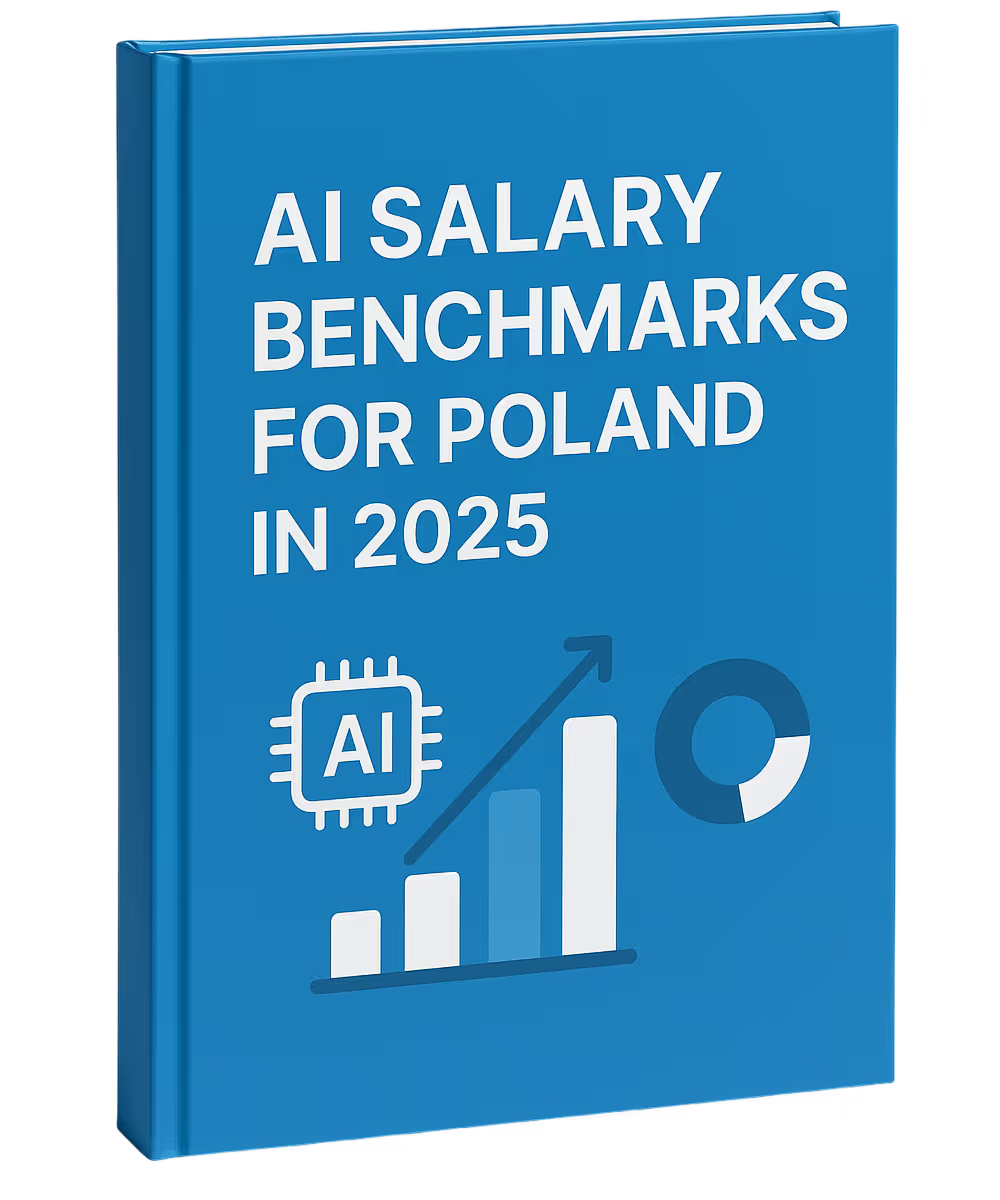

Based on a comprehensive analysis of 250+ AI/ML job postings and 600+ overall job postings analyzed in June 2025, this report provides detailed insights into salary trends, geographic distribution, skill demands, and market dynamics in Poland's artificial intelligence and machine learning sector.
The analysis reveals a vibrant and competitive market with significant opportunities for companies looking to expand their AI/ML operations in Poland.
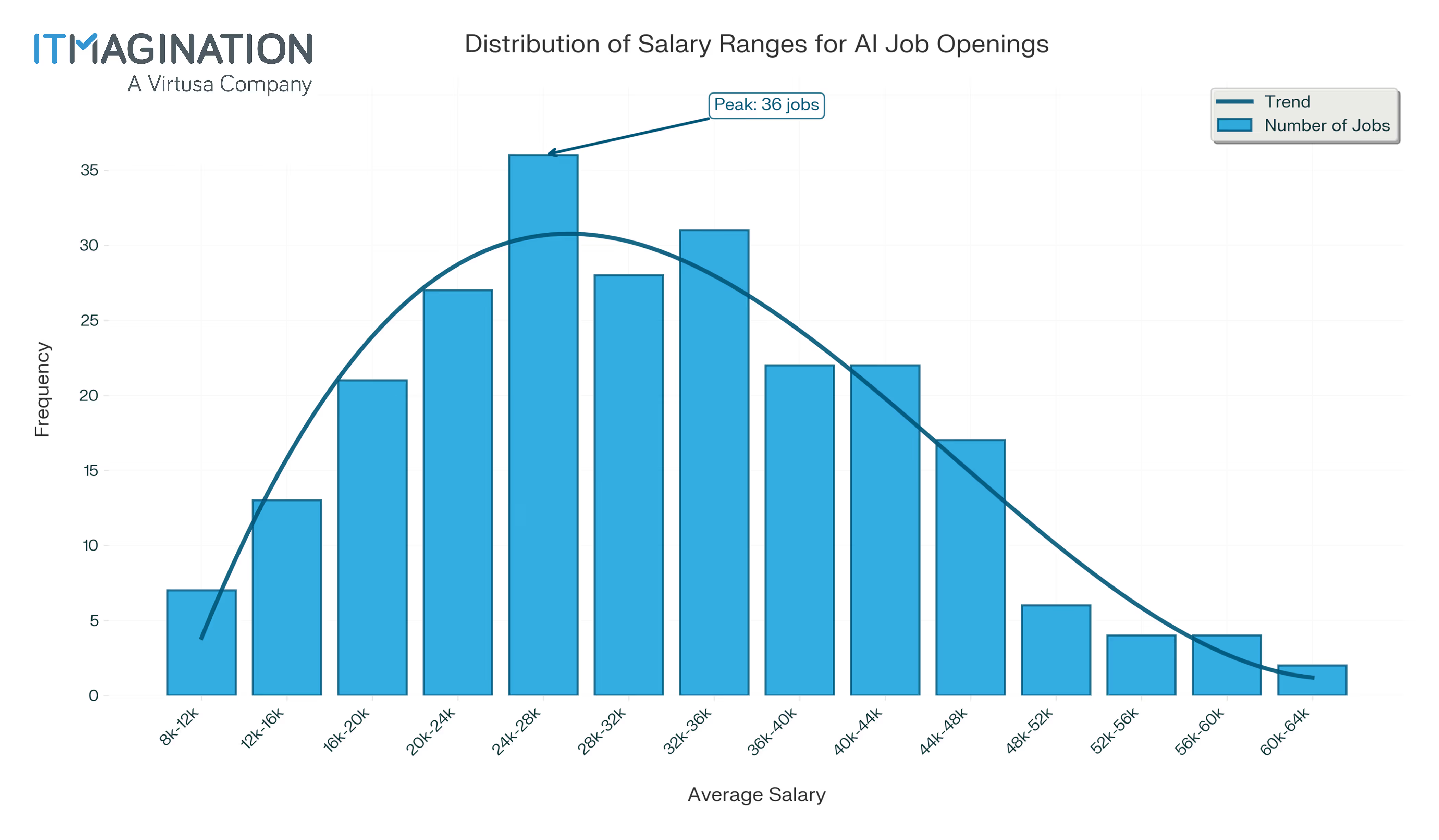
Below are brief observations and recommendations which we will dive into in the full report.
Compensation and Sourcing:
Skills and Technology:
Hiring Considerations:
AI/ML Positions vs. Others (Data, Backend, Frontend):
By understanding these market dynamics and tailoring your hiring strategies accordingly, you can successfully build your AI/ML team in Poland.
Poland has emerged as a key player in the European AI ecosystem. A strong talent pool, competitive cost structure, and growing investment in AI research and innovation have made it a strategic location for both local startups and global enterprises. As a result, the demand for AI professionals is on the rise, not only in Warsaw but increasingly in other cities and through remote-first roles.
Salaries in AI-related fields across Poland vary significantly based on a combination of factors such as experience level, role specialization, geographic location, company size, and specific technical skills required.

This report breaks down compensation by experience, specialization, location, and employer profile to offer a clear, data-informed view of the current market.
As in most tech fields, seniority is one of the strongest indicators of how much professionals in AI can expect to earn. However, in Poland, salary levels are also shaped by the type of contract (UoP or B2B), the city where the role is based, and the seniority of the position within the organization.
Here’s a breakdown of the average monthly salaries for different experience levels in AI roles:
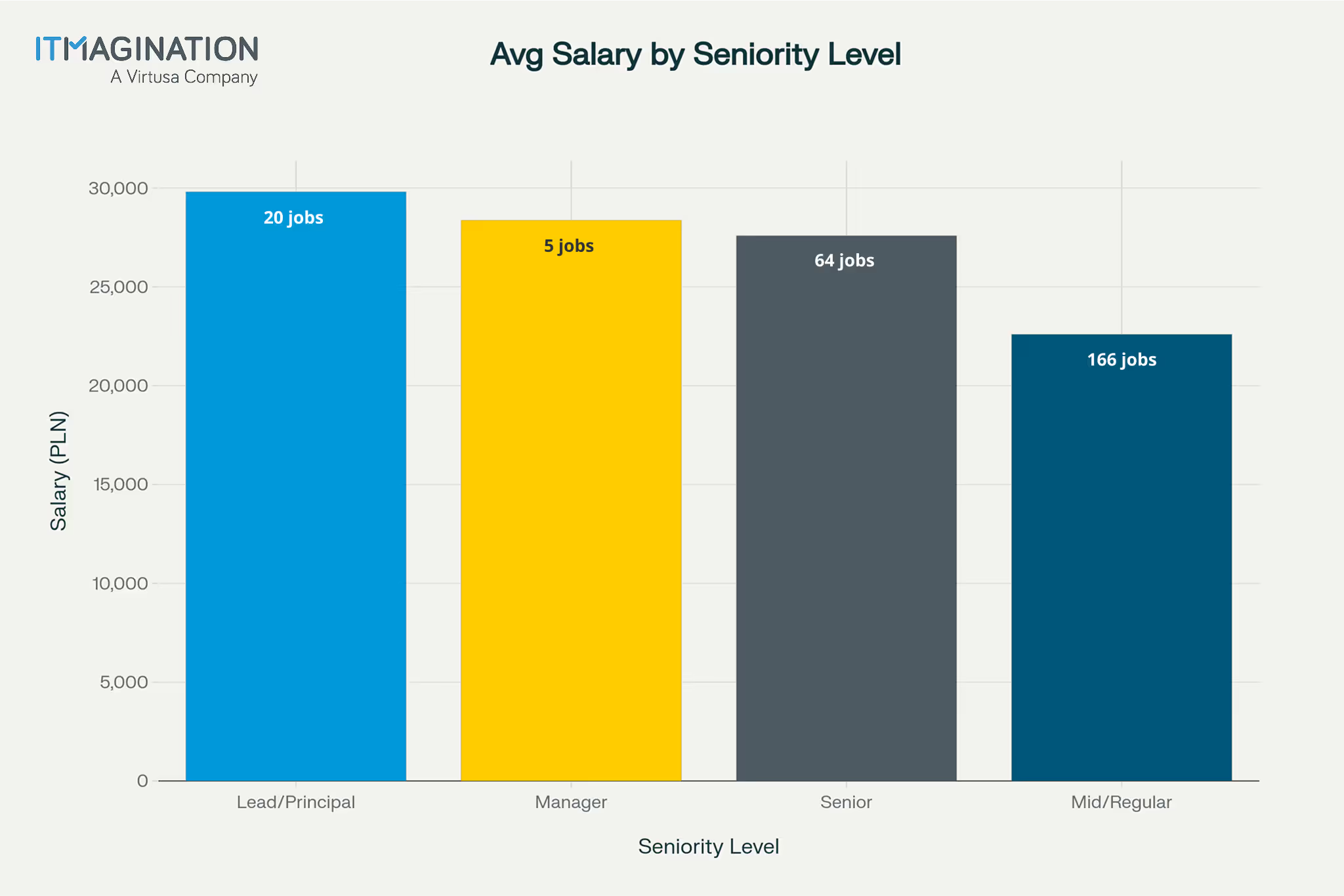
Mid-level specialists typically see a significant step up in both responsibility and pay. Salaries in this range fall between 14 000 (3 300 EUR) and 19 700 PLN (4 600 EUR) per month on an employment contract (UoP), and up to 21 000 PLN (4 950 EUR) per month for those working on B2B contracts.
At this level, professionals are often expected to take ownership of components such as ML pipelines, model optimization, or integrations with production systems. Specialists in high-demand areas like NLP or MLOps often land at the higher end of the range.
Senior AI professionals are among the most in-demand, and that’s reflected in their compensation. Salaries typically range between 18 000 PLN (4 200 EUR) and 23 600 PLN (5 550 EUR) per month on UoP, with B2B contracts going up to 26 900 PLN (6 300 EUR) per month.
Senior team members often take on system architecture, team mentoring, and cross-functional collaboration. In Warsaw and among leading tech firms, salaries toward the top of this range are increasingly common.
For professionals stepping into strategic or leadership roles, monthly salaries often exceed 25 000 PLN (5 900 EUR), with the average monthly salary reaching nearly 28 400 PLN (6 650 EUR) for managers.
These positions come with responsibilities like setting AI direction, managing teams, and aligning machine learning initiatives with broader business goals.
Interestingly, the salary ranges for Managers are often lower than those of Leads/Architects, and even below those of senior engineers in some cases. In larger companies or international organizations, additional bonuses, stock options, or international exposure can increase the total compensation package.
In Poland’s AI job market, what you know matters just as much as how long you’ve been working. While experience and seniority shape salary ranges, the specific skills a professional brings to the table, technical, domain-specific, or interpersonal, can have a major impact on compensation.
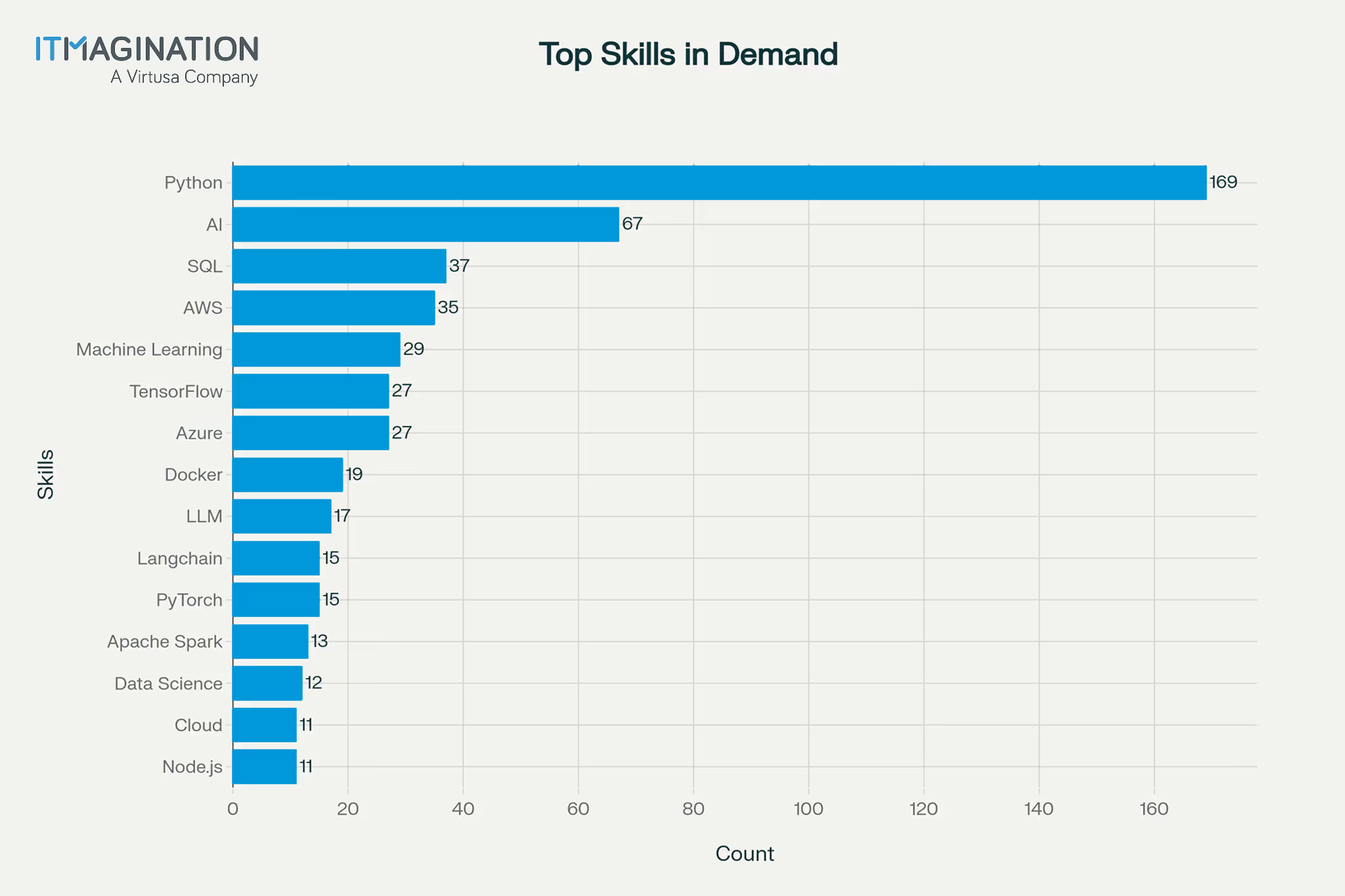
This dominance reflects Python's role as the de facto standard for AI/ML development, data science, and machine learning applications. Jobs requiring Python skills average 24 773 PLN (5 800 EUR) monthly, representing a 250 PLN (~1%) premium over the market average.
While Python remains a universal baseline, the surrounding tech stacks reflect each company type’s scale, priorities, and AI maturity.
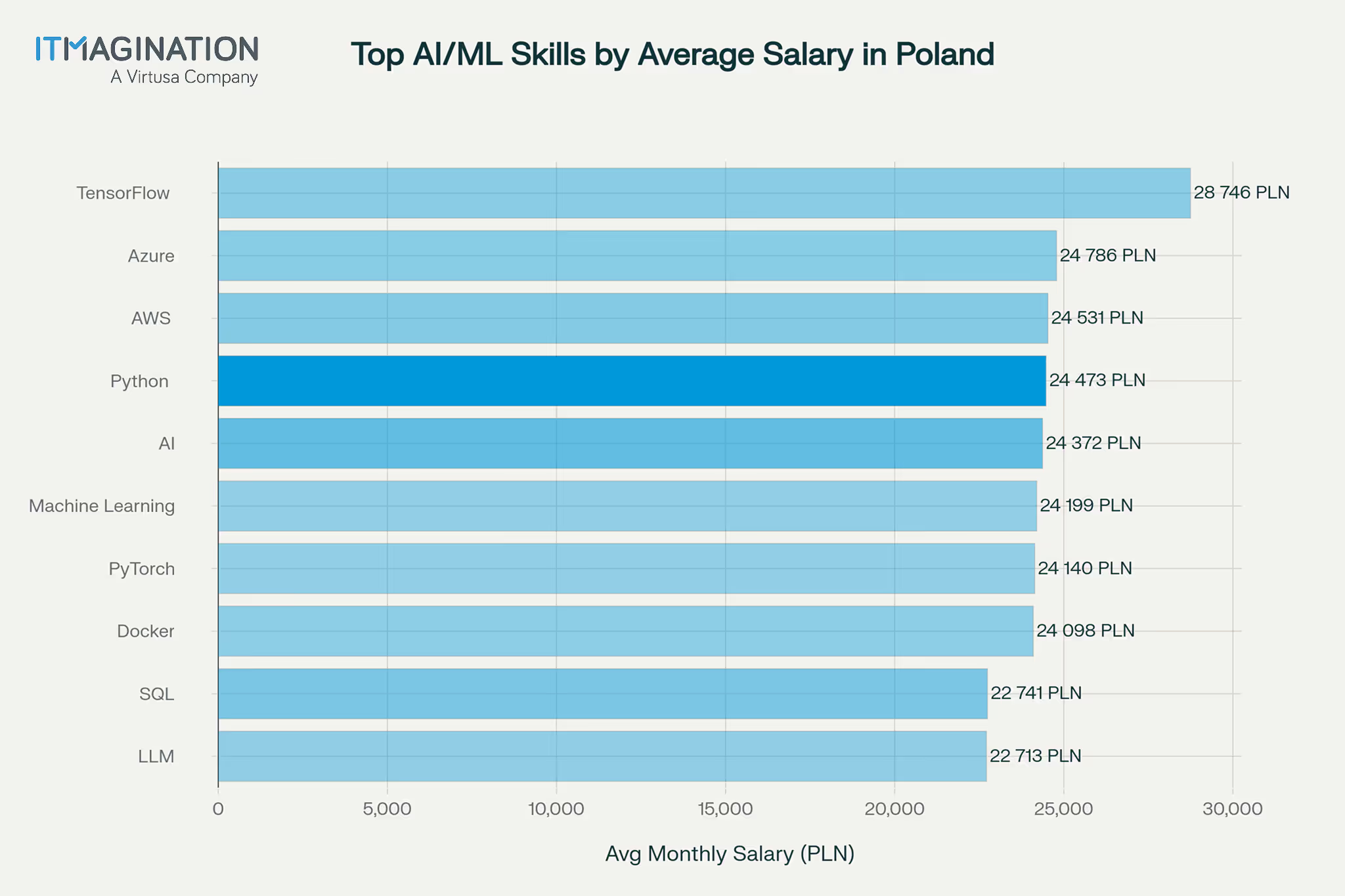
For example, TensorFlow commands the highest skill premium at 27 104 PLN (6 350 EUR) monthly, indicating strong demand for deep learning expertise. AWS cloud skills also show significant value at 25 896 PLN (6 100 EUR) monthly, reflecting the importance of scalable infrastructure.
Analytics and DevOps skills maintain relevance with SQL appearing in 31 postings and Docker in 16 positions. Version control through Git appears in 10 postings, while Kubernetes container orchestration is mentioned 8 times, showing the integration of modern software development practices.
Note: One potential issue with our data is that it is likely that there are more skills required which are not marked explicitly within the job posting. For example knowledge of modern software development practices may not be marked but required, same as with knowledge of specific cloud platforms. This may skew some of the data and insights.
At enterprise level, job descriptions consistently include Python, Azure, and Databricks, reflecting the heavy use of cloud infrastructure and enterprise data platforms. Skills such as LLMs, NLP, GenAI, MLOps, and DevOps are frequently paired with TensorFlow, PyTorch, and scikit-learn, indicating that candidates are expected to develop and deploy AI systems at scale.
Additional emphasis is placed on integration tools like SQL, Docker, FastAPI, and orchestration frameworks like IaC (Infrastructure as Code). The presence of LangChain, Azure AI Foundry, and spaCy points to the growing focus on language model governance and retrieval-augmented generation (RAG) techniques in corporate AI deployments.
What this means for applicants: High specialization is rewarded. Candidates with a strong command of cloud-native AI platforms, large-scale model deployment, and cross-functional integration will typically see the highest salary brackets, especially for roles like AI Engineer, AI Architect, or Machine Learning Lead.
Medium-sized companies maintain a strong focus on Python, Azure, AWS, and Databricks, but the stack broadens to include Terraform, Kubernetes, and Apache Spark, pointing to a need for full-cycle delivery from data ingestion to model deployment.
A recurring pattern in job postings is the combination of cloud engineering (Azure, GCP, AWS) with tools like Airflow, LangChain, and DBT, and integration frameworks like REST, OpenAPI, and GraphQL. This suggests an operational model where AI professionals are expected to not only build models, but also manage pipelines and APIs.
Additionally, tools like Microsoft Power BI, Tableau, and Snowflake appear more frequently, showing the intersection of AI and BI in mid-size firms. Skills in ML frameworks (TensorFlow, PyTorch) are often accompanied by MLOps, reinforcing the focus on reproducible and scalable AI workflows.
What this means for applicants: Versatility matters. Medium-sized firms look for engineers who can deliver end-to-end AI solutions and collaborate across teams. While the salary range is slightly below large enterprises, the required skill set is almost as broad, particularly for MLOps Engineers, AI Developers, and Data Scientists.
Startups and smaller tech firms center their AI hiring around Python, often combined with JavaScript, Node.js, TypeScript, and React, highlighting a need for hybrid skill sets bridging AI and software engineering. These companies heavily use emerging technologies like LangChain, LlamaIndex, OpenAI API, and RAG frameworks, with frequent mentions of FastAPI, Flask, and Pydantic-AI.
There is a noticeable preference for flexible deployment stacks, including Docker, Kubernetes, Apache Airflow, and GCP, but with less emphasis on formal governance or enterprise-grade MLOps. Instead, small firms prioritize speed of development and integration into products, often involving GenAI, ChatGPT variants, and agentic frameworks.
What this means for applicants: Expect fast-paced, innovation-driven environments. Candidates comfortable with rapid experimentation, hands-on deployment, and working across multiple toolchains will thrive. While salaries may vary by funding stage, many small firms offer above-average compensation for specialists in LLMs, LangChain, or generative AI APIs.
In the AI field, what you specialize in can significantly affect how much you earn. While most roles share core skills, like Python, data handling, and model development, the nature of the work, its complexity, and its business impact can push salaries in very different directions.
The distribution reflects the market's focus on practical implementation rather than research roles.
Here's how average annual salaries break down across key AI specializations in Poland across seniorities:
AI Engineer positions continue to see rapid growth, driven by the widespread adoption of large language models (LLMs), enterprise-grade agents, and AI-powered automation.
Demand is especially strong for professionals skilled in working with foundation models from platforms like Azure OpenAI, Amazon Bedrock, and open-source stacks integrated via LangChain, vector databases, and Retrieval-Augmented Generation (RAG) pipelines.
Mid to senior-level AI Engineers are particularly sought after in sectors like banking, financial services, and insurance. The average salary for these roles is around 23 078 PLN/month (5 450 EUR), with experienced specialists and those working on production-grade LLM systems often earning well above that range.
Machine Learning Engineer is one of the most in-demand roles in the AI space and consistently ranks among the highest-paying. These professionals focus on building, training, and deploying machine learning models in real-world applications.
Proficiency with tools like TensorFlow, Azure Machine Learning Studio, and experience with cloud platforms such as Azure, AWS, or GCP can significantly increase earning potential. According to our research, Machine Learning Engineers in Poland earn an average of 26 638 PLN (6 250 EUR) per month.
A flexible and widely adopted role, Data Scientists work across industries to extract insights from data, build predictive models, and inform business decisions.
Because the role varies, from analytics-focused to highly specialized machine learning work, so do salaries. On average, experienced Data Scientists earn around 21 832 PLN/month (5 150 EUR/month), with top ranges going much higher.
Python Engineers are the backbone of many AI/ML teams, providing the foundational codebase, infrastructure, and integrations needed for intelligent systems to function. While many AI/ML roles include Python as a required skillset, they are not always marked as "Python Engineers".
Typical responsibilities include developing microservices, maintaining ETL processes, building model-serving infrastructure, and collaborating closely with data scientists or ML engineers. In some organizations, Python developers are also expected to contribute to performance optimization, MLOps automation, and deployment on cloud platforms such as AWS, Azure, or GCP.
Demand is highest in companies prioritizing Python-centric stacks and scalable AI infrastructure. Common tools include FastAPI, Flask, Docker, Git, Kubernetes, and orchestration frameworks like Airflow.
Average compensation for Python Engineers in AI-focused environments sits around 23 944 PLN/month (5 650 EUR/month), with those supporting advanced AI/ML systems, including LLM-based applications, often earning more.
Where someone works in Poland can make a big difference in what they earn in an AI/ML role. While skills and experience matter most, location still plays a role, mostly because of differences in demand, company presence, and cost of living.
Warsaw clearly leads the way. It has the highest number of job postings and the widest salary range, including some of the top-paying roles in the country. Many large companies and international tech hubs are based here, which helps push salaries up. At the same time, the data shows some below-market offers for mid/regular seniority engineers, especially by small businesses which brings Warsaw’s average to below some other cities. This is not necessarily a nefarious action by those companies, they may be less able to compete against the big players in Warsaw.
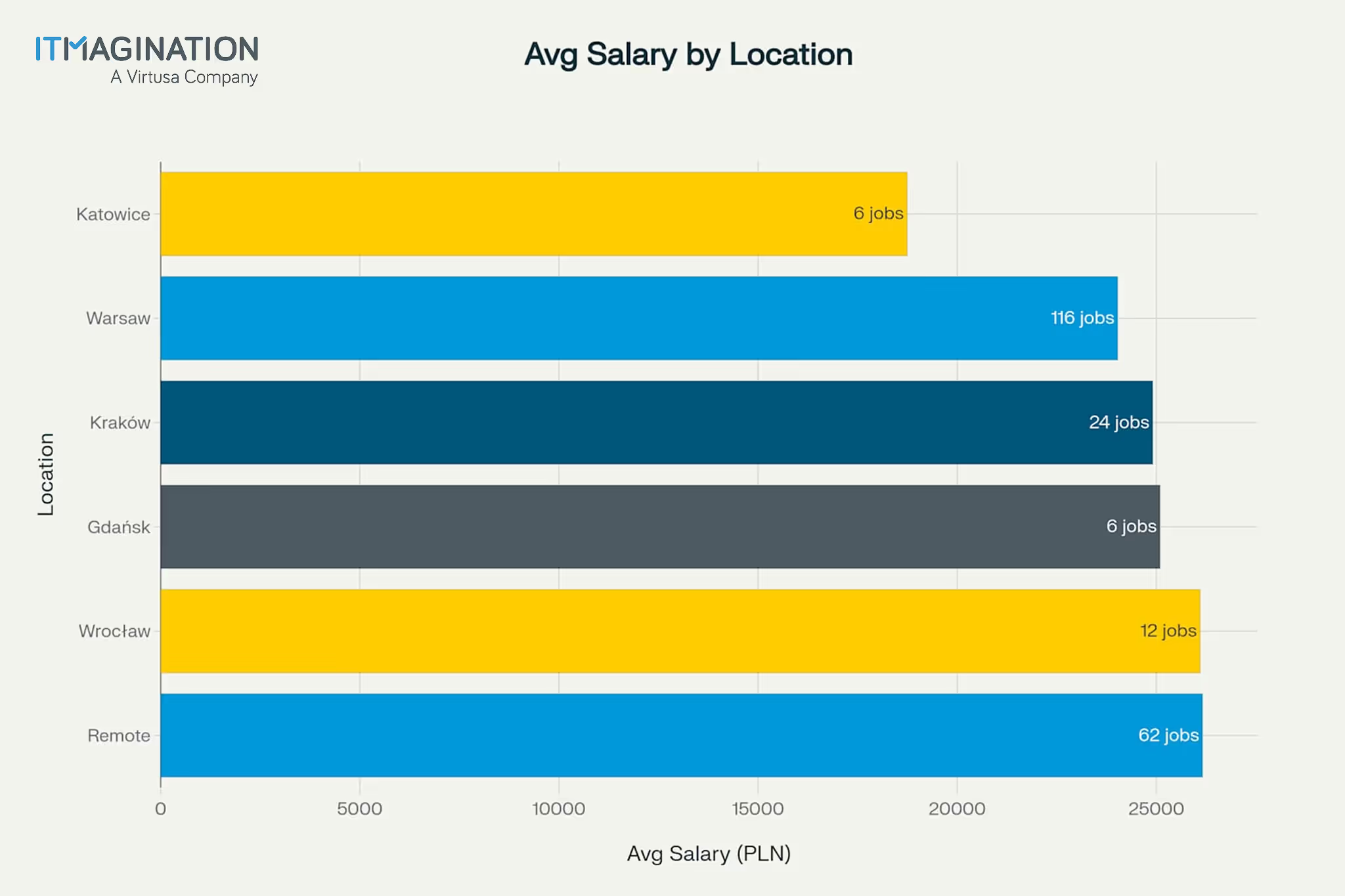
These figures reflect where companies are investing in AI talent, and where job seekers are most likely to find opportunity.
Remote roles are also very common. In fact, they make up a large share of all AI job listings, sitting right behind Warsaw. What’s interesting is that remote positions often offer salaries on par with or even higher than those based in smaller cities, especially for senior roles or hard-to-find specializations.
Kraków and Wrocław also show up regularly on the AI job map. They are mature tech hubs which are still growing. Salaries here as well as other cities other than Warsaw tend to be more consistent across roles, with a lower number of outliers.
Gdańsk has fewer listings and the tightest salary range among the major cities. It’s still an active tech hub, but the AI job market there is smaller, even though the pay levels are on par with other major cities.
Here’s a quick summary of average salaries by location:
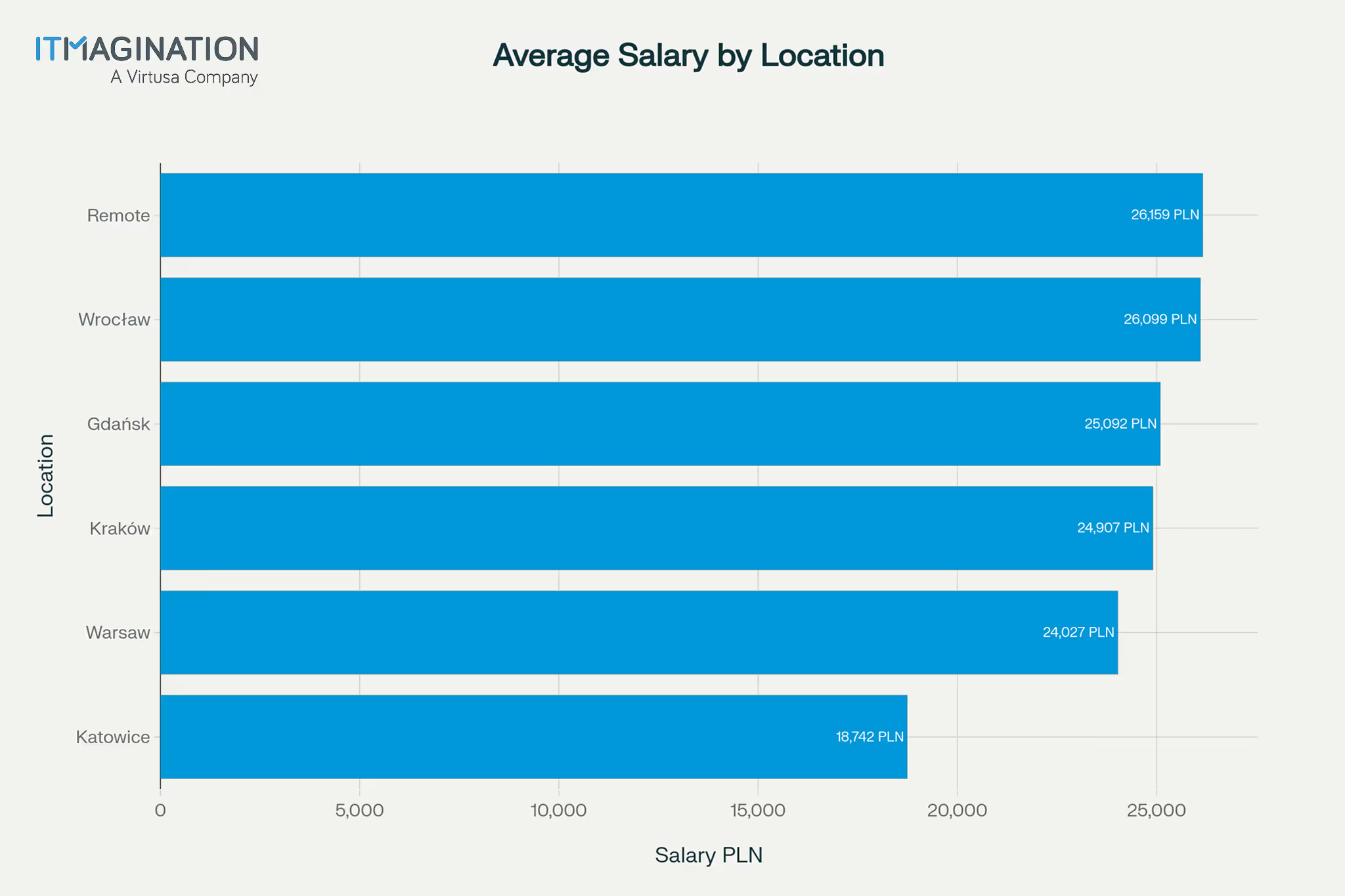
While Wrocław currently shows the highest average salary, the difference between top cities is relatively small, by a margin of ~2%. These differences reflect local employer concentration, industry maturity, and regional demand.
Even as companies embrace remote hiring, geography continues to impact pay, especially for mid-to-senior roles. Here's why:
The average AI/ML position offers 24 495 PLN (5 750 EUR) per month, representing a premium of 1 213 PLN (285 EUR) over the average of other tech areas. This salary advantage varies across seniority levels, with the greatest difference observed at Mid/Regular levels.
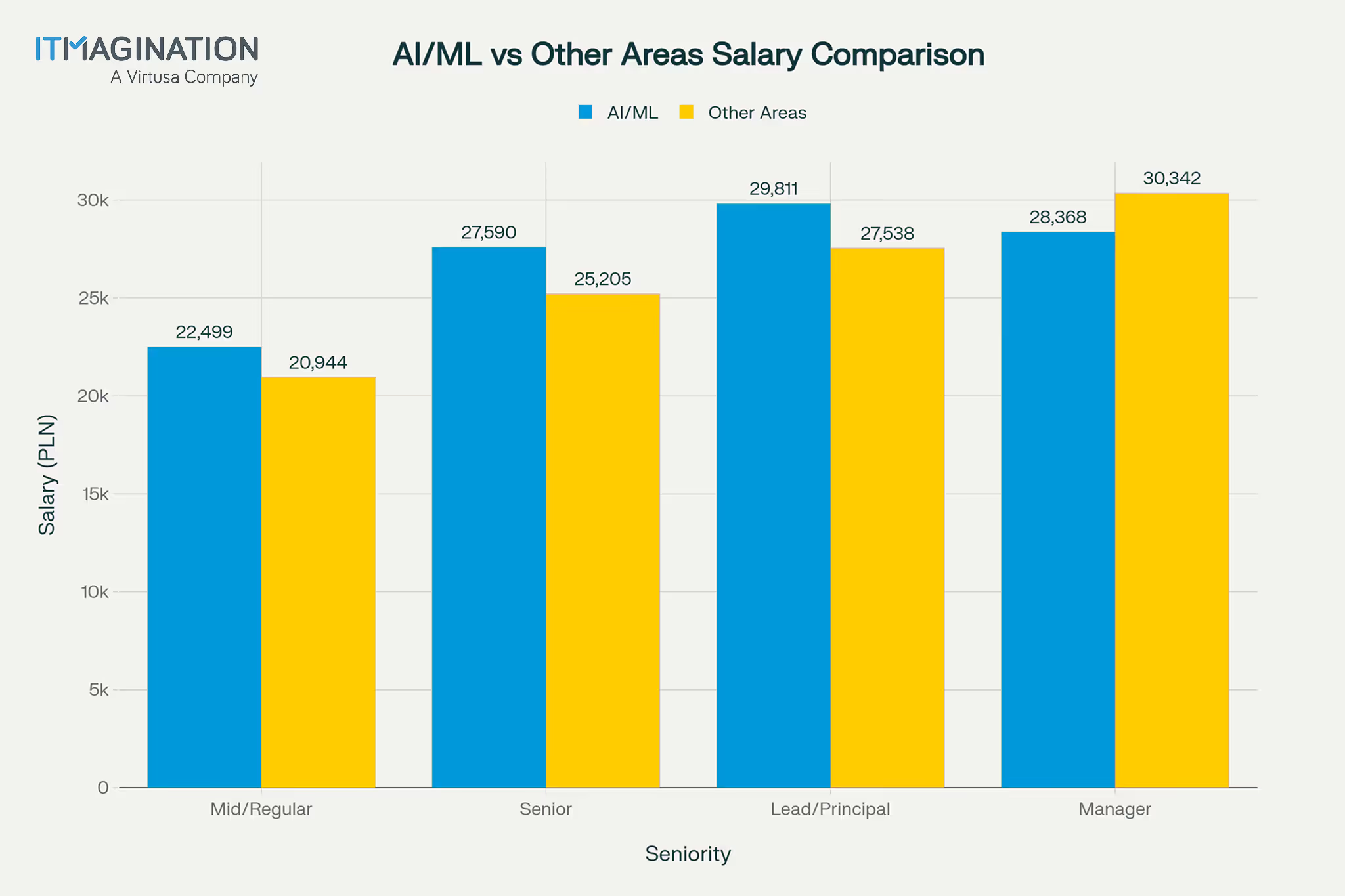
The comprehensive salary analysis reveals notable differences in compensation across tech areas. AI/ML positions show not only higher average salaries but also a wider range, suggesting greater variability in compensation packages.
%202.avif)
The median salary for AI/ML jobs is 24 000 PLN (5 650 EUR) per month, compared to 25 100 PLN (5 900 EUR) for Data roles, 23 510 PLN (5 500 EUR) for Backend positions, and 20 000 PLN (4 700 EUR) for Frontend roles. While Data positions show a higher median salary, AI/ML positions offer higher maximum salaries, with top positions reaching 62 400 PLN (14 650 EUR) per month.
The distribution of salaries reveals that AI/ML positions tend to cluster at higher salary ranges (24 000 - 30 000 PLN / month; 5 650 EUR - 7 050 EUR / month), while Frontend positions show more concentration in lower ranges. Backend and Data positions show similar distributions but with different spread patterns.
AI/ML positions command a significant premium over other tech areas, particularly compared to Frontend roles where the difference reaches 2 880 PLN (675 EUR) per month on average. The premium over Backend positions averages 1 219 PLN (285 EUR), while the advantage over Data roles is more modest at 688 PLN per month.
This salary advantage reflects the specialized skills required for AI/ML roles, including expertise in areas such as machine learning algorithms, neural networks, natural language processing, and computer vision.
Seniority level has a significant impact on compensation across all tech areas, with a clear progression from Mid/Regular to Manager positions. Average salaries range from 21 705 PLN for Mid/Regular roles to 29 445 PLN for Manager positions.
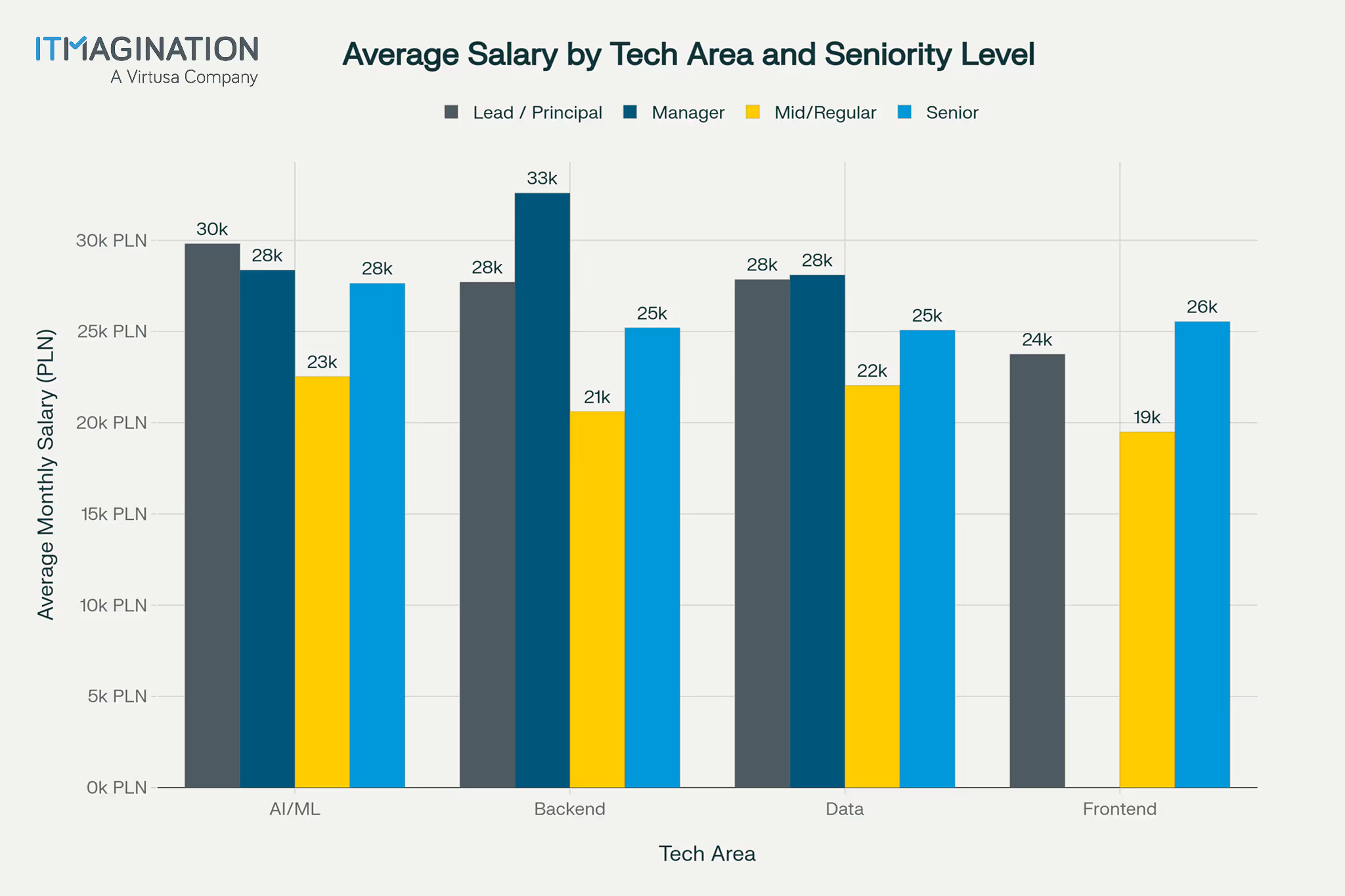
The greatest number of job postings (359 positions, 58.1% of total) are for Mid/Regular roles, followed by Senior positions (194 jobs, 31.4%), indicating that companies are primarily seeking experienced professionals rather than entry-level talent.
The analysis shows that most tech positions across all areas require approximately 4 skillsets, but with notable variations in range and consistency.
All four major technology areas—AI/ML, Backend, Frontend, and Data converge around this 4-skillset standard as their most common requirement.
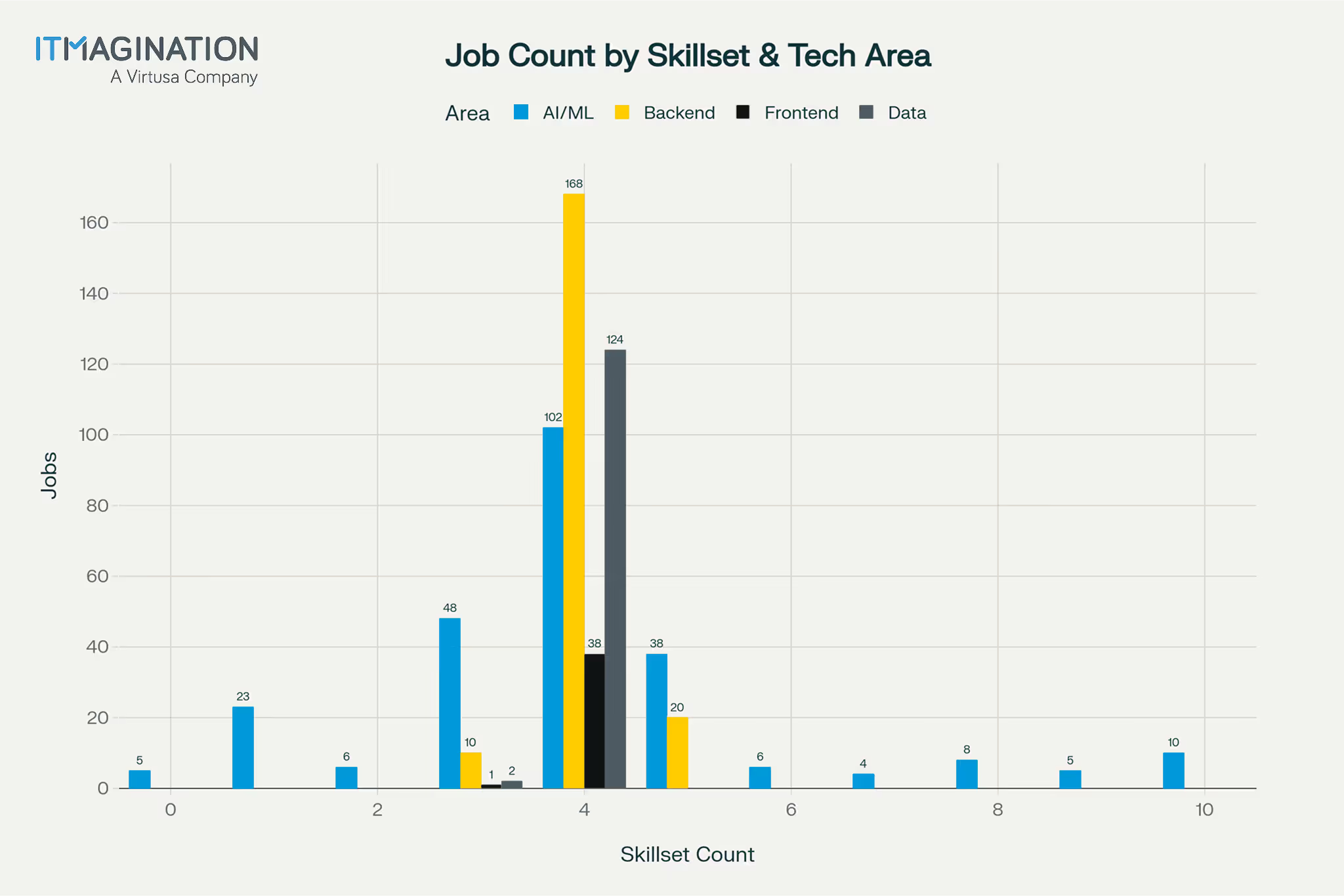
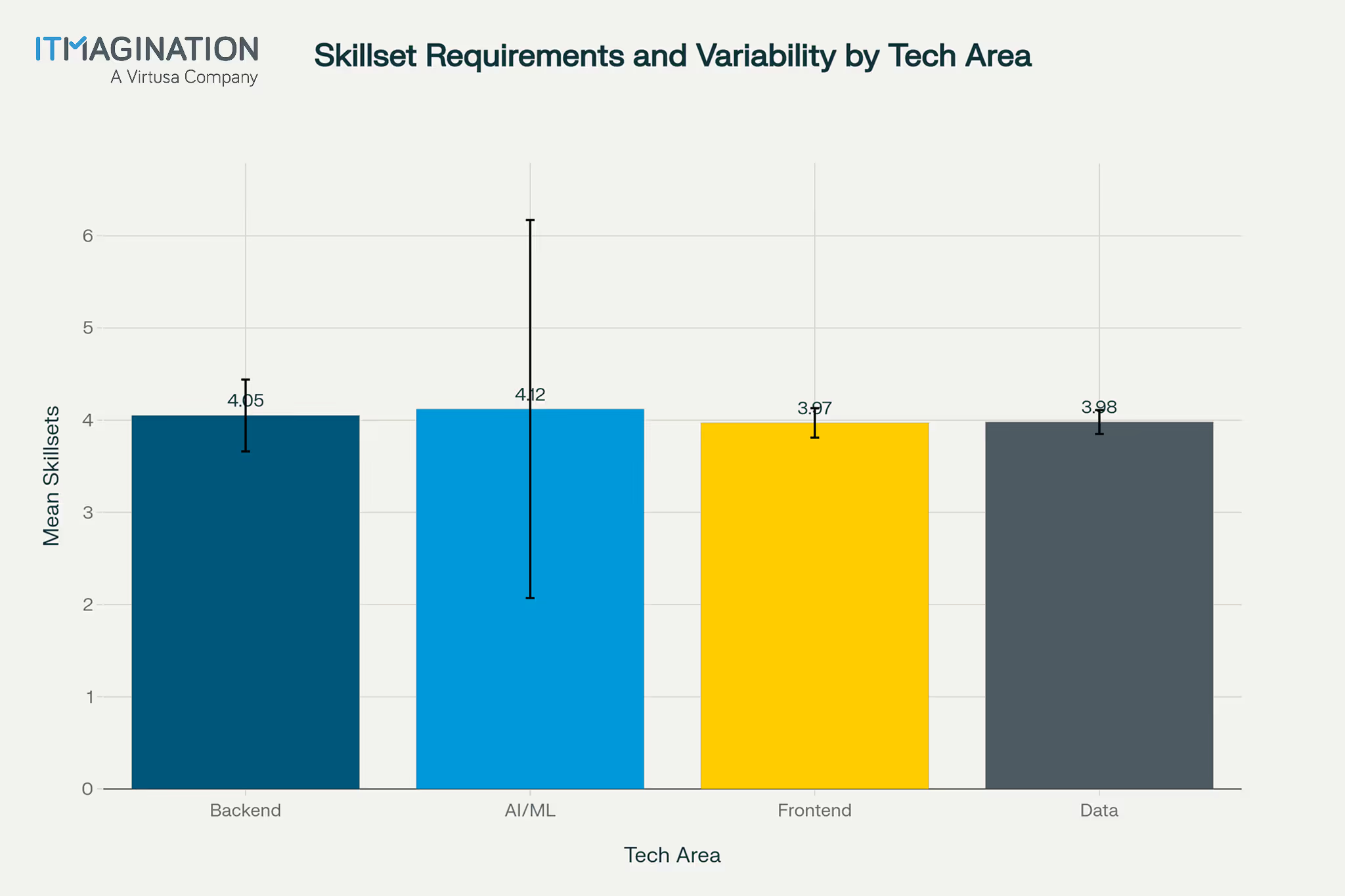
This extensive range reflects the diverse nature of AI/ML roles, from specialized research positions to comprehensive full-stack AI engineering roles, and the non-consolidated market where there are many tools and skills needed which are changing month-to-month.
Backend development: maintains relatively consistent requirements, typically demanding 3-5 skillsets with a mean of 4.05 and low variability (standard deviation: 0.39). This consistency suggests well-established patterns in backend development practices.
Frontend development: shows the most uniform requirements, with skillset counts ranging only from 3-4 (mean: 3.97, standard deviation: 0.16). This narrow range indicates standardized expectations for frontend developers.
Data roles: exhibit similar uniformity to Frontend positions, requiring 3-4 skillsets (mean: 3.98, standard deviation: 0.13).
AI/ML functions as a meta-discipline that uniquely bridges multiple technical domains. Unlike traditional areas that represent specialized technical stacks, AI/ML combines elements from computer science, mathematics and statistics, domain expertise, infrastructure, and data engineering.
The rapid evolution of AI/ML technologies contributes significantly to skill diversity. Emerging technologies like Large Language Models (5.8% prevalence) and Generative AI (3.3%) represent cutting-edge requirements.
Additionally, the coexistence of competing frameworks (TensorFlow vs PyTorch both appearing in significant percentages) and cloud-agnostic requirements (both AWS and Azure needed) creates natural skill diversification.
AI/ML projects demonstrate exceptional variety in technical requirements, spanning computer vision, natural language processing, traditional machine learning, research versus production deployment, real-time versus batch processing, and different data types and scales. This project diversity necessitates correspondingly diverse skill requirements.
Python dominates the AI/ML skillset requirements, appearing in >66% of all skill mentions within the area. The "AI" skill itself represents 6.6% of mentions, followed by SQL (3.9%), AWS (3.5%), and Azure (2.6%).
Java leads backend requirements at 15.2% of skill mentions, with Python following at 10.5%. The .NET framework represents 7.9% of mentions, while PHP accounts for 3.2%.
React dominates frontend requirements with 27.1% of skill mentions, significantly higher than other areas' leading skills. Angular follows at 14.2%, with JavaScript at 13.5%, TypeScript at 7.1%, and HTML at 5.8%.
The analysis demonstrates that while skillset requirements follow predictable patterns across technology areas, their relationship to compensation is more complex than simple skill counting might suggest.
Organizations and professionals should consider role context, market positioning, and specialization depth alongside skill breadth when evaluating positions and compensation expectations.
AI salaries in Poland show noticeable variation depending on company size, largely driven by differences in funding, project scope, international exposure, contract flexibility, and organizational maturity. Here is how AI job compensation typically compares across small, medium, and large companies.

Startups and boutique tech firms tend to offer competitive compensation, especially for AI-focused roles that demand advanced skills. Many of these companies rely on B2B contracts, which allow them to offer higher take-home net salaries despite having smaller budgets.
Additionally, small companies often work on cutting-edge or niche AI use cases, which can appeal to candidates looking for impact and technical challenges. However, they may not offer extensive benefits packages or long-term employment security.
Mid-sized firms often strike a balance between competitive salaries and organizational stability. These companies are typically scaling rapidly or operating in specialized verticals like technology consulting, financial services, or healthcare.
While salaries may be slightly lower than those in some startups at the top end, benefits such as career development programs, partial remote flexibility, and structured teams make these roles appealing. Their compensation is often tied to clear technical ladders and project responsibility levels.
Large multinational corporations and enterprises usually offer the highest average salaries, especially for senior-level or highly specialized AI roles. Their compensation structures reflect both their financial capacity and global standards.
These firms are more likely to hire under employment contracts (UoP) and may offer additional benefits like stock options, and wider health insurance coverage. While they may be slower to adopt emerging technologies compared to startups, they provide structured career paths, larger-scale AI applications, and access to international teams.
The AI job market in Poland is showing no signs of slowing down. In fact, all signs point toward continued growth, both in the number of roles and in the range of specializations emerging across the industry.
Overall, the outlook is positive. The combination of local talent, international investment, and evolving technology means Poland’s AI job market is not only growing, it’s becoming more diverse, better paid, and more globally connected.
Hiring AI talent in Poland is increasingly competitive, and not just among local companies, but also against international firms hiring remotely or setting up local hubs. Here are practical considerations for employers who want to attract and retain strong candidates in this environment:
The AI job market in Poland is growing, but so is the competition. To stand out, it's not enough to just meet the job requirements. The most successful candidates are the ones who can clearly show what they’ve built, how they think, and how they stay current in a fast-moving field. Here are a few ways to stay ahead:
While this report outlines key trends and benchmarks, several areas still need deeper exploration to get a more complete and reliable picture of AI compensation in Poland.

The salary distribution reveals a near-normal curve with a slight right skew, indicating a healthy and mature job market for AI/ML professionals in Poland. While salaries are distributed across a wide range from 8 000 PLN to 64 000 PLN per month (1 900 EUR - 15 000 EUR per month), most positions are in the 20 000-30 000 PLN per month (4 700 EUR - 7 050 EUR per month) salary range.
Peak Salary Range
The highest concentration of AI/ML jobs falls in the 24k-28k PLN (5.6k-6.6k EUR) per month range, representing 15.0% of all available roles. This peak suggests that most companies are offering competitive mid-level salaries that align with market standards for AI/ML professionals.
Market Concentration
Approximately two-thirds (67%) of all AI/ML positions fall within the 20k-36k PLN per month (4.7k-8.5k EUR per month) salary range, indicating strong market consensus around competitive compensation levels. The weighted average salary across all positions is 31 117 PLN (7 300 EUR) per month.
Unsure if your budget or internal expertise aligns with the AI salary benchmarks in Poland highlighted in this report? Concerned about how to attract top AI talent? Or are you looking to integrate advanced AI/ML solutions but haven't finalized your implementation roadmap?
Don't worry! We encourage you to book a free consultation call with our team of AI experts. We'll help you shape a ramp-up and implementation plan tailored to your needs.
If you're curious about our experience, you can read more about our AI/ML expertise here. We can also share additional case studies during a 1:1 call which we can’t disclose openly publicly due to NDA terms.
ITMAGINATION, a technology consulting company on the market for over 16 years, has a proven track record of successfully implementing AI/ML solutions for global enterprises including L’Oreal, Tikkurila, Cheil, and LPP, alongside other organizations covered under NDAs.
Our team of AI/ML engineers is experienced in deploying AI/ML solutions across diverse scenarios, customizing solutions, integrating with various tech stacks to overcome any limitations, and providing ongoing training and maintenance.
You can read more about our AI/ML expertise here.























With over 25 years of technology experience in the financial services industry, Amit has spearheaded initiatives to modernize payments platforms, transform core banking systems, build new cash management platforms, launch embedded finance products, and leverage AI to reduce sanctions false positives.

I am a technology strategist and executive architect with over 20 years of experience designing, scaling, and modernizing digital platforms for startups, scale-ups, and enterprises.
My expertise lies in translating complex technology into business-aligned outcomes; driving innovation, resilience, and growth.
As Chief Architect, Fractional CTO, and founder of The Future Thinker, I help organizations navigate transformation through a blend of deep technical insight and forward-thinking strategy.

With over 16 years in the IT industry, including more than a decade at ITMAGINATION, I specialize in backend development, cloud architecture, and Microsoft technologies, helping businesses design scalable, high-quality solutions with a value-first approach.

With over 13 years of experience in software development, architecture, and engineering leadership, I help businesses build scalable, high-performance solutions across industries, specializing in modernization, enterprise integration, and AI-driven personalization.

For over two decades, Girish has been instrumental in helping Fortune 500 companies define and deliver their digital future.
A proven leader in global digital transformation, he has successfully led large-scale digital platform and digital engineering initiatives.
Today, he continues to pioneer cutting-edge solutions, blending AI and digital innovation to create tangible business value.
.avif)
With over 14 Years of professional experience, I am passionate about enabling businesses to unlock value through transformative AI-driven solutions by aligning innovative data strategies with organizational goals.
Dedicated to fostering collaboration and delivering impactful results, I strive to bring diverse perspectives to every initiative while contributing to Virtusa's cutting-edge offerings in Europe.